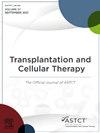Granulocyte Colony-Stimulating Factor–Primed Bone Marrow Transplantation Experience in 350 Matched Sibling Donor Grafts for Severe Thalassemia
IF 3.6
3区 医学
Q2 HEMATOLOGY
引用次数: 0
Abstract
Background
For matched related hematopoietic cell transplantation (HCT) for non-malignant diseases, most centers prefer bone marrow (BM) over peripheral blood stem cell (PBSC) grafts owing to increased risk of chronic graft-versus-host disease (GVHD–associated with the latter. BM generally entails delayed neutrophil and platelet recovery compared with PBSC transplants. Granulocyte colony-stimulating factor–primed bone marrow (G-BM) has been associated with faster hematologic recovery while retaining a decreased risk of GVHD. Moreover, it may allow for reduced marrow collection volumes.
Objectives
We retrospectively analyzed our experience with G-BM as graft source from July 2015 to February 2023 across 350 consecutive first matched sibling transplants in children with severe thalassemia in four centers in India.
Findings
We observed that G-BM is associated with rapid hematologic recovery with relatively low rates of cytomegalovirus reactivation (16%), low rates of moderate to severe GVHD (grade 3-4 acute GVHD was 5% and moderate to severe chronic GVHD was 3%), and reduced marrow collection volumes (12.5 ml/kg of donor's weight), and thus is potentially safer for both donors and recipients compared with standard bone marrow. This observation was made in a relatively homogenous cohort of multiply transfused patients with thalassemia who are at high risk of rejection. None of the donors required third-party blood transfusion irrespective of donor–recipient weight discrepancy.
Conclusion
Our experience suggests that G-BM is associated with prompt engraftment and very low rates of moderate or severe GVHD. It also appears to be safe for donors and decreases the risk for third-party red blood cell transfusions. Finally, it is relatively easy and inexpensive to collect. G-BM should be strongly considered as a preferable graft source in matched-related donor transplantations for thalassemia and potentially other transplant indications.
350例配型兄弟姐妹供体移植治疗重度地中海贫血的g - csf诱导骨髓移植经验
背景:对于非恶性疾病的匹配相关造血细胞供体移植(HCT),大多数中心更倾向于骨髓(BM)而不是外周干细胞(PBSC)移植,因为后者增加了慢性GVHD的风险。与PBSC移植相比,骨髓移植通常需要延迟中性粒细胞和血小板恢复。g - csf引发的骨髓(G-BM)与更快的血液学恢复有关,同时保持GVHD的风险降低。此外,它可能会减少骨髓收集量。目的:我们回顾性分析了2015年7月至2023年2月在印度四个中心连续350例重度地中海贫血儿童首次匹配兄弟姐妹移植的G-BM作为移植物来源的经验。研究结果:我们观察到G-BM与快速血液学恢复相关,CMV再激活率相对较低(16%),中重度GVHD发生率较低(3-4级急性GVHD为5%,中重度慢性GVHD为3%),骨髓采集量减少(12.5 ml/Kg供者体重),因此与标准骨髓相比,对供者和受体都可能更安全。这一观察结果是在一个相对均匀的多次输血的地中海贫血患者队列中得出的,这些患者有很高的排斥风险。无论供者和受者体重差异如何,均无供者需要第三方输血。结论:我们的经验表明,G-BM与快速植入和极低的中度或重度GVHD发生率相关。它似乎对献血者也是安全的,并降低了第三方红细胞输注的风险。最后,它的收集相对容易和便宜。G-BM应被强烈认为是匹配相关供体移植治疗地中海贫血和潜在的其他移植适应症的首选移植物来源。
本文章由计算机程序翻译,如有差异,请以英文原文为准。
求助全文
约1分钟内获得全文
求助全文
来源期刊

Transplantation and Cellular Therapy
Medicine-Hematology
CiteScore
7.00
自引率
15.60%
发文量
1061
审稿时长
51 days
 求助内容:
求助内容: 应助结果提醒方式:
应助结果提醒方式:


